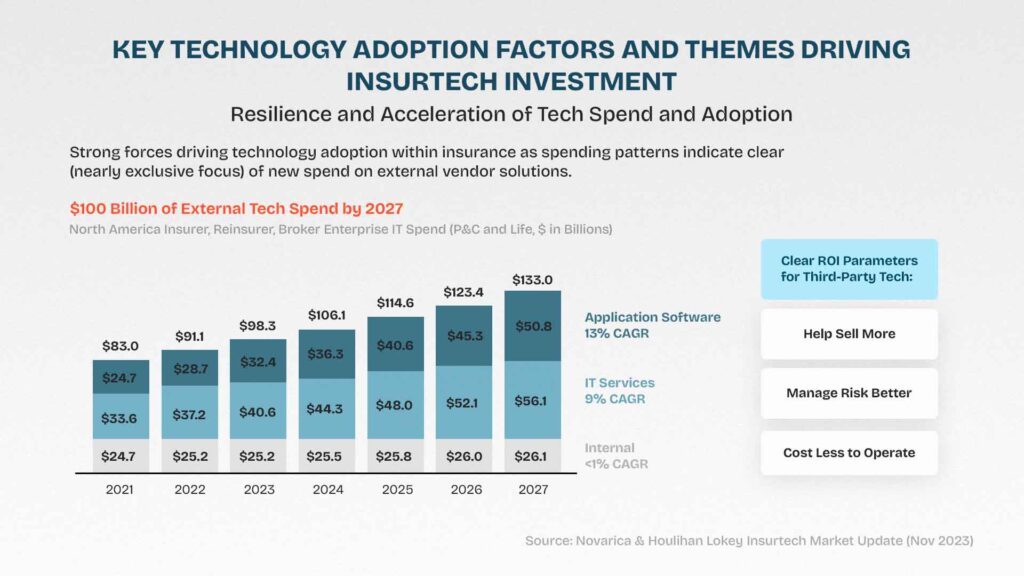AI and machine learning have become integral in transforming the insurance industry. These technologies not only boost operational efficiency but also enhance personalization, improve customer interactions, and drive innovation. As the digital transformation accelerates and new technologies emerge at an unprecedented pace, AI-powered platforms are becoming increasingly sophisticated and essential for insurers.
As insurers face mounting pressure to innovate and integrate AI, the age-old debate of “build vs. buy” has evolved. The question now isn’t just about whether to develop in-house solutions or purchase third-party platforms—it’s about whether an insurer’s internal tech teams can match the pace of innovation set by specialized insurtech companies.
According to Forrester Research’s early 2024 report, 45% of insurance firms are already using AI to enhance underwriting, claims processing, and customer service. Yet, as the push to adopt AI grows, insurers are confronted with a critical choice: build custom solutions internally or turn to external vendors. This decision goes beyond mere technology adoption—it’s about ensuring long-term success in an ever-evolving marketplace.
The Shift in the Build vs. Buy Discussion: A More Complex Choice
The traditional binary debate of “build vs. buy” is no longer straightforward. The emergence of specialized insurtech platforms has made the “buy” option much more appealing. In today’s landscape, the real question for insurers is whether investing in external technology—solutions that are already AI-driven and market-tested—could provide a faster, more efficient path to modernizing their operations.
The Challenges of Building In-House AI Solutions
For insurance companies aiming to leverage AI, developing a custom platform in-house is no small feat. Hiring the right talent, particularly in emerging technologies, is expensive and time-consuming. A qualified software developer in AI can command an annual salary ranging from $100,000 to $200,000. If an insurance company requires a whole team of specialists—including data scientists, engineers, and product managers—these costs can quickly escalate into the millions.
Beyond salaries, the cost of development tools, software licenses, and infrastructure adds another layer of complexity. A high-quality AI-driven insurance platform demands a dedicated team of experts to handle everything from product development and data integration to onboarding, training, and ongoing system updates.
Why Smaller and Mid-Sized Insurers Are Choosing Buy Over Build
In the past, smaller insurance carriers had little choice but to develop homegrown systems to meet their needs. While these legacy solutions served the industry well for years, the rapid pace of digital transformation has changed. Now, insurers of all sizes are rethinking their technology strategy in favor of agility and speed.
As the digital landscape evolves, the role of the Chief Information Officer (CIO) has expanded to include titles like Chief Digital Officer, Chief Data Officer, and Chief Innovation Officer—roles focused specifically on driving technological change and operational efficiency. With the pressure to digitize every part of the insurance value chain, the need for rapid innovation is critical.
Insurance companies are not software firms. Building in-house tech solutions—whether it’s for claims processing or AI-driven underwriting—is akin to a bakery deciding to grow its own wheat for flour. The resources required to develop complex AI systems are better invested elsewhere. Insurers know there are faster, more cost-effective ways to access cutting-edge technology.
The Competitive Advantage of Buying Insurtech Solutions
Time is of the essence, and insurers who spend too long augmenting internal tech teams to modernize legacy systems risk falling behind. Meanwhile, their competitors may be opting for AI-powered insurtech platforms that offer out-of-the-box solutions, integrated AI features, and rapid deployment. In today’s fast-paced market, this agility often tips the scales in favor of buying over building.
Ultimately, for many insurance companies—especially small and mid-sized carriers—the “build vs buy analysis” debate has shifted from a theoretical question to a strategic imperative. Investing in proven, external insurtech solutions is becoming the clear choice for insurers looking to stay competitive in a rapidly changing industry.













